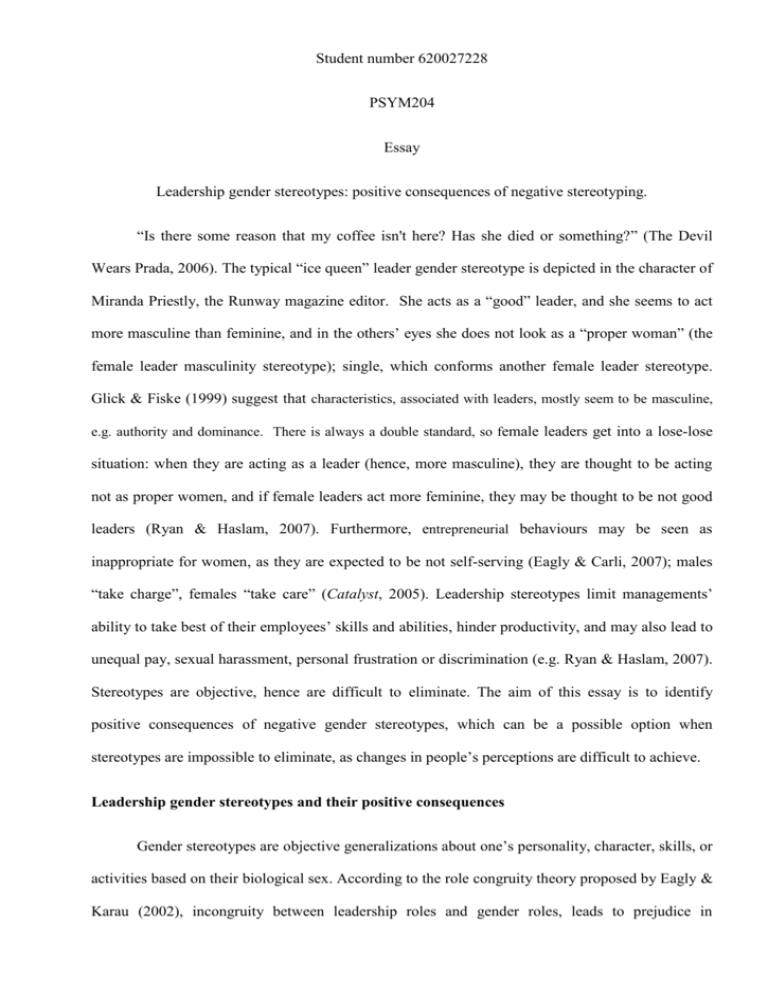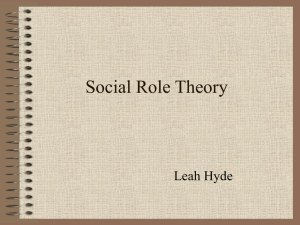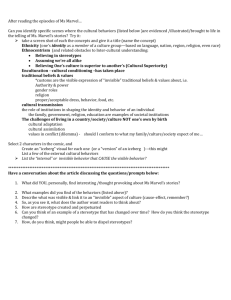PSYM204_ESSAY
advertisement

Student number 620027228 PSYM204 Essay Leadership gender stereotypes: positive consequences of negative stereotyping. “Is there some reason that my coffee isn't here? Has she died or something?” (The Devil Wears Prada, 2006). The typical “ice queen” leader gender stereotype is depicted in the character of Miranda Priestly, the Runway magazine editor. She acts as a “good” leader, and she seems to act more masculine than feminine, and in the others’ eyes she does not look as a “proper woman” (the female leader masculinity stereotype); single, which conforms another female leader stereotype. Glick & Fiske (1999) suggest that characteristics, associated with leaders, mostly seem to be masculine, e.g. authority and dominance. There is always a double standard, so female leaders get into a lose-lose situation: when they are acting as a leader (hence, more masculine), they are thought to be acting not as proper women, and if female leaders act more feminine, they may be thought to be not good leaders (Ryan & Haslam, 2007). Furthermore, entrepreneurial behaviours may be seen as inappropriate for women, as they are expected to be not self-serving (Eagly & Carli, 2007); males “take charge”, females “take care” (Catalyst, 2005). Leadership stereotypes limit managements’ ability to take best of their employees’ skills and abilities, hinder productivity, and may also lead to unequal pay, sexual harassment, personal frustration or discrimination (e.g. Ryan & Haslam, 2007). Stereotypes are objective, hence are difficult to eliminate. The aim of this essay is to identify positive consequences of negative gender stereotypes, which can be a possible option when stereotypes are impossible to eliminate, as changes in people’s perceptions are difficult to achieve. Leadership gender stereotypes and their positive consequences Gender stereotypes are objective generalizations about one’s personality, character, skills, or activities based on their biological sex. According to the role congruity theory proposed by Eagly & Karau (2002), incongruity between leadership roles and gender roles, leads to prejudice in judgments and attitude. Current gender stereotypes show men as “agentic” or “taking charge”, achievement oriented; and women are seen as “communal”, “taking care”, being helpful, relationship-oriented. Moreover, general associations with leader attributes (such as problem solving, self-confidence, assertiveness, risk taking), and with manager attributes (such leadership potential, being active and initiative) are stereotypically seen as typically masculine behaviour (Heilman, 2001); “think manager- think male” (Eagly & Sczesny, 2009; Sczesny, 2003), “think crisis-think female” (Haslam & Ryan, 2007). Haslam & Ryan (2008) suggest that there is a “glass ceiling” which does not allow women to gain access to higher positions, leadership positions, and moreover, they are more likely to be hired on positions with greater risk of failure. “The only time to run a woman is when things look so bad that your only chance is to do something dramatic” (cited in Burrell, 1993; 123). One of the reasons why the “glass cliff” phenomenon exists is that it is believed that females, having such traits as tact, intuition and understanding, are seen as most valuable and suitable for organizations in crisis (Madden, 2011). Perhaps, one of possible positive consequences of this phenomenon is that female leaders who succeed in solving problems and “saving” companies in crisis are on high demand in other companies: they have a status of managers who succeeded in problem solving (which is an important quality in one’s profile), they, in fact, are achievement oriented. In example, my mother has never been looking for a job by herself – head hunters usually offer her worthy vacancies, as they consider her to be an experienced manager, because in each company she succeeds in problem solving and saving the company from crisis. However, there is a negative consequence as well: employers may hire such female leaders only on those positions which expect problem solving and saving a company from crisis. Based on Psychological research, Catalyst (2005) gives a list of qualities which are commonly seen as typically women’s and men’s traits. Women’s traits, such as affectionate, pleasant, sympathetic, mild, sentimental, warm, friendly and emotional, which conform feminine stereotype, are less related to leadership. The researchers also state that women are more likely to have position power in organisations, which relates to how leaders use their positions in organisations for motivation of others. In fact, position power is usually associated with rewarding, supporting, and mentoring. Whereas men’s traits are dominance, aggressiveness, achievement orientation, being ambitious, tough, rational, unemotional and active. Catalyst (2005) suggests that men are more likely to have interpersonal power, which is associated with team-building, inspiring, and problem-solving, and relates to leader’s expertise and charisma, inspiration of others to achieve common goals. Women are seen as lacking such kind of interpersonal power, and, consequently, there is a general tendency of doubt in women’s problem-solving competence (which counters the “glass cliff” phenomenon, where it is one of the main reasons why women get hired on high positions). Warm and kind women may be seen as lacking authority and weak. Eagly (1992) suggests that when a male manager acts in a forceful way, he is thought to be a good leader, whereas a female leader would be considered unacceptably pushy. Yet, you can get an effective result in both ways: warm and friendly female-dominated group, or dominant and unemotional atmosphere in a male-dominated group. It also depends on individual. In example, in a Ukrainian telecommunication company were both female- and maledominated groups. The female-dominated group achieved more effective results, as the male leader in the second group appeared to be less ambitious and less goal-oriented. Forbes (2011) gives a list of typical stereotypes about powerful women: Ice Queen, masculine, single and lonely, tough, weak, emotional, angry, conniving. If a female leader is being emotional, she is seen as too fragile or unstable, and if she is being professional and ambitious-she is icy and masculine. It is believed that successful female leaders sacrifice their personal life, and spend more time on job. Eagly & Johnson (1990) found that women leaders are more democratic than male leaders. They also display more transformational leadership (which involves intellectual stimulation, inspiration and motivation) than men, and most women actually succeeded in becoming leaders by adopting the masculine style of leadership. Eagly suggests that “transformational leadership” which includes team-building, inspiring, developing others’ skills, stimulating creativity, is the most flexible model of leadership which is neither feminine, nor masculine. Nevertheless, being an Ice Queen, as well as being masculine and tough, female leader is respected and has more power, authority and opportunities. Furthermore, there is an example of certain leader behaviour with possible consequences (on examples of famous persons who conform the mentioned stereotypes), and female leaders may choose a management strategy. Such kind of leadership is effective for organisations: female leaders who conform such stereotypes are problemsolving, achievement-oriented; they can cope with critical situations and maintain discipline among employees. Early study conducted by Schein (1973, 1975) revealed that both men and women were more likely to choose a man as who possesses “typical” characteristics of a good leader. Other stereotypes suggest that the female/male employee proportion, the amount of female leaders and their masculinity/femininity depends on sector and industry. Traditionally, there are more female managers in “typically feminine” service sectors and education (especially primary schools), while in “typically masculine” sectors there are more male managers (Blum, Fields & Goodman, 1994). This can be explained by gender roles in everyday and family life. Garcia-Retamero & LópezZafra’s (2006) study revealed that males were seen by the participants as masculine in a “typically masculine” industry (i.e. auto manufacturing) and as feminine in a more feminine industry (i.e. clothing manufacturing). Gardiner and Tiggemann (1999) found that in male-dominated industries both sexes did not differ in interpersonal leadership orientation, however in female-dominated structures, women showed more interpersonal orientation. Another stereotype refers to the fact that female leaders are more likely to have more authority and power in a typically female group (same with males), as people may feel most comfortable with those who are similar to them (including gender). According to Rhode (2000), women in traditionally male-dominated structures may remain ignorant of professional development opportunities. In addition, same thing can be said about women of colour: Edmondson Bell & Nkomo (2001) suggest that women may experience isolation. A female leader in a mostly male group does not have much authority. We can assume that the main positive consequence is that under such circumstances when it depends on industry or sector, women are not hired on hard physical jobs. In case when in some sectors groups are mainly of same gender, it is convenient for the employees: e.g. my male colleague did not feel convenient on daily meetings because the female leader of our group was giving too much unnecessary information, giving too many details and talking too much in general while he was expecting a few necessary points and main ideas. Moreover, under such circumstances when there is mostly a same-gender group, the positive side is that the same-gender leader may feel more comfortable in such environment (as female and male leadership styles slightly differ), as well as having more authority and being more respected. Reduction of workplace gender stereotyping Bowring (2004) suggests that avoiding bipolar attitude in research of leadership may show more variable results: there is much more variability among women in their leadership styles, and between men, but not just between genders (Hyde, 2005). Indeed, the perspective of comparing female leaders separately from male leaders may show perspective of professional and leadership development for both genders, comparison of female and male leadership styles and showing a general universal profile of a leader. Pittinsky, Bacon & Welle (2007) suggest that there is a difference (which leads to incongruity between social and personal expectations) between how women think they should act, how others expect them to act, and how women actually begin to act. The researchers propose a degendering strategy for leadership, the Great-Women approach, which considers not functions, but styles and traits (Pittinsky et al. 2007). UK studies have found that pre-teen girls were more likely to choose typically feminine careers for future (e.g. nursing), as they were in doubt about their abilities and perspectives, whereas boys were absolutely confident in their choices in industry (Bettridge, 2013). That means, stereotypes influence kids’ perception as well. Perhaps stereotype elimination in childhood would be one of the most important steps on the way of total change of people’s perceptions of leadership. Rhode & Kellerman (2006) point out such individual strategies: self-awareness (women should be clear on their values and goals); leadership styles and capabilities (to reach their goals); models, mentors, and networks (support and guidance is needed); time management, work and family choices (which means setting priorities); contributions and limits of self-help (useful points and limitations of all-purpose self-help literature); women’s leadership on women’s issues. Indeed, women are personalities, professionals, citizens, and mothers; female leadership is in their hands – they can build and challenge. Among organisational strategies, the researchers distinguish: commitment and accountability (which stand for ensuring equal access to leadership opportunities, responsibility for results in recruitment); measuring and monitoring results (assessments of results, comparison, projects that ensure equal opportunities); life quality, work/family initiatives (policies regarding childcare, leave, family issues; flexibility); mentoring and networks (to improve employees’ skills, avoid isolation; encourage communication, sharing interests). Indeed, such policies are necessary in each company: they ensure safety and development of employees. If a group’s norms value equality, women can be seen as appropriate leaders for both female and male dominated groups (Haslam & Ryan, 2007). Perhaps, establishing norms and rules in an organisation, as well as encouraging learning more about each other would make a positive change in elimination of stereotypes. Moreover, showing success of female leaders as an example, especially in “masculine industries” would also make a positive change. Remedios et al. (2011) have shown that adding negatively stereotyped information to other negatively stereotyped information may show positive results. However, this may be inappropriate in an organization. It is also believed that leadership stereotypes are losing power, and a new type of leadership – conscious leadership – is believed to be the style that blends traditional female and male traits (Bettridge, 2013). Conscious leadership is built on respect, integrity, love, transparency, courage, transformation, playfulness and co-creation. Indeed, hearing and understanding, accepting people the way they are is very important for a leader. A good leader should be trustworthy and honest, inspiring, productive and empowering, sharing true feelings, intellectually curious, have courage to go on no matter what, express joyfulness of life. To sum up, all of the mentioned in the essay concerns leadership management styles, but not work in particular. In other words, it is more important how successful and effective one works, therefore, the result is the most important. Counter-stereotyping, workplace policies, or ignoring stereotypes is a personal decision of each manager. The author considers that each company chooses options, styles and values which promote effectiveness of business development, and if that means keeping a glass ceiling above female employee’s heads – that is the choice of the company. References The Devil Wears Prada, Dir. David Frankel. 20th Century Fox, 2006. Film Goudreau, J. (2011). The 10 worst stereotypes about powerful women. Forbes. retrieved from forbes.com/sites/jennagoudreau/2011/10/24/worst-stereotypes-powerful-women-christine-lagardehillary-clinton Glick, P., & Fiske, S. T. (2001). An ambivalent alliance: Hostile and benevolent sexism as complementary justifications for gender inequality. American Psychologist, 56, 109 – 118. Haslam, A., Ryan, M, (2007) The glass cliff: exploring the dynamics surrounding the appointment of women to precarious leadership positions. Academy of Management Review Vol.32, No.2, 549572 Forsyth, D. R. (2009). Group dynamics. New York: Wadsworth. 245-281 Heilman, M.E. (2001). Description and prescription: How gender stereotypes prevent women’s ascent up the organizational ladder. Journal of Social Issues, 57, 657-674. Heilman, M. E., Block, C. J., & Martell, R. F. (1995) Sex stereotypes: Do they influence perceptions of managers? Journal of Social Behavior and Personality, 10, 237–252. Kaiser, C. R., & Miller, C. T. (2001). Stop complaining! The social costs of making attributions to discrimination. Personality and Social Psychology Bulletin, 27, 254 –263. Mayhew, R., How to Reduce Workplace Stereotyping, Demand Media retrieved from smallbusiness.chron.com/reduce-workplace-stereotyping-11114.html Meindl, J. R., Ehrlich, S. B., & Dukerich, J. M. (1985). The romance of leadership. Administrative Science Quarterly, 30, 78 –102. Pittinsky, T., Bacon, L., & Welle, B. (2007) The Great Women theory of leadership: perils of positive stereotypes and precarious pedestals. Pp. 93-125 in Women and Leadership: The State of Play and Strategies for Change. Edited by Kellerman, B., and Rhode, D., San Francisco, CA: Jossey-Bass. Pillai, R., & Meindl, J. R. (1998) Context and charisma: A meso level approach to the relationship of organic structure, collectivism and crisis to charismatic leadership. Journal of Management, 24, 643– 671. Postmes, T., Branscombe, N. R., Spears, R., & Young, H. (1999) Comparative processes in personal and group judgments: Resolving the discrepancy. Journal of Personality and Social Psychology, 76, 320 –338. Reicher, S. D., Haslam, S. A., & Hopkins, N. (2005) Social identity and the dynamics of leadership: Leaders and followers as collaborative agents in the transformation of social reality. Leadership Quarterly, 16, 547–568. Schein, V. E. (2001) A global look at psychological barriers to women’s progress in management. Journal of Social Issues, 57, 675– 688. Sczesny, S. (2003) A closer look beneath the surface: Various facets of the think-manager-thinkmale stereotype. Sex Roles, 49, 353–363.








